12 Best Fillers for Under Eye Bags That Work
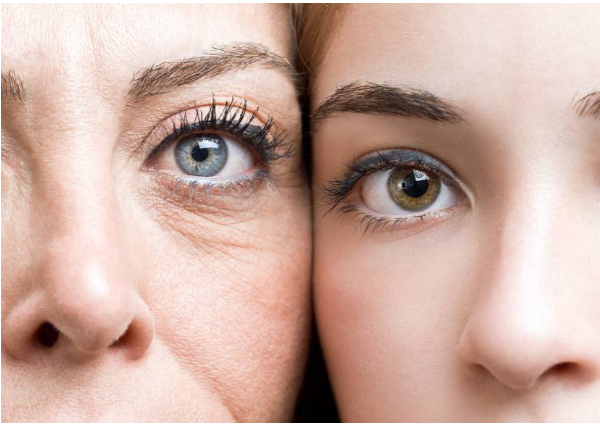
Many patients are concerned about eye bags and turn to fillers for under eye bags. The technique adds volume to the skin and smooths out wrinkles and lines. Many different types of dermal fillers are available, and each has advantages and disadvantages.
The most common type of dermal filler is hyaluronic acid. This substance is found naturally in the skin, and it helps to keep the skin hydrated and plump. However, hyaluronic acid fillers can sometimes cause side effects such as bruising and swelling.
Another popular type of dermal filler is collagen. Protein-like collagen helps to support the skin. Collagen fillers can provide a natural-looking result but may only last for a short time as other fillers.
Dermal fillers are a secure and effective way to improve the look of wrinkles, lines, and other imperfections on the skin. Sometimes, dermal fillers can enhance the lips or minimize the scars’ appearance. They can also add volume to certain parts of the face.
FILLERS FOR UNDER EYE BAGS TEAR TROUGHS AND UNDER-EYE HOLLOWS
If you want to make under-eye bags look less noticeable, tear troughs, or under-eye hollows, consider using fillers. They are an injectable type that can help plump up and smooth out the skin. They’re made from hyaluronic acid, which occurs naturally in the body.
Fillers can be an excellent option for under eye bags, tear troughs, or under-eye hollows without surgery. They are also typically much less expensive than surgery and have a shorter recovery time.
One way to combat under eye bags is to use fillers. Fillers are cosmetic injectables that help plump the skin and smooth wrinkles and lines. Many kinds of fillers are on the market, and your doctor or aesthetician can help you choose the best one based on your needs.
Fillers can provide a more permanent solution when compared to topical creams and serums. Additionally, fillers can help restore volume, plump up and firm the skin, and reduce wrinkles and fine lines. However, it’s important to note that the results of fillers can vary, and you may have to get touchups periodically to maintain the desired results.
DO YOUR RESEARCH AND SEE A REPUTABLE INJECTOR FOR THE JOB
Before getting Injectable fillers for under eye bags and dark circles. If you’re considering getting one, you want to ensure you’re getting them from a reputable source. Injectables can be a great way to achieve a younger look, but they can also be dangerous if not done correctly.
You can do a few things to research an injector before committing to a procedure:
Look for before-and-after photos of previous clients. This will give you an idea of the injector’s skill level. Read online reviews from other clients.
Ensure the injector is experienced and certified in the specific procedure you’re interested in. A good idea of the injector’s skills and abilities would be best. Take your time with your appearance – research and find a reputable injector.
For example, when considering a cosmetic procedure cosmetic for under eye wrinkles or eye lift surgery, it is essential to do your research and see a reputable injector.
Eye lift surgery can reduce the signs of facial aging by reducing wrinkles and creating a more youthful look. A qualified injector will have experience with this type of procedure and be able to provide quality results that will help you look your best.
Ask questions and research the injector’s experience, training, and background. Find someone you trust and read reviews from previous clients. It is essential to understand that the results of dermal filler injections vary and should be discussed thoroughly with an injector before committing to treatment.
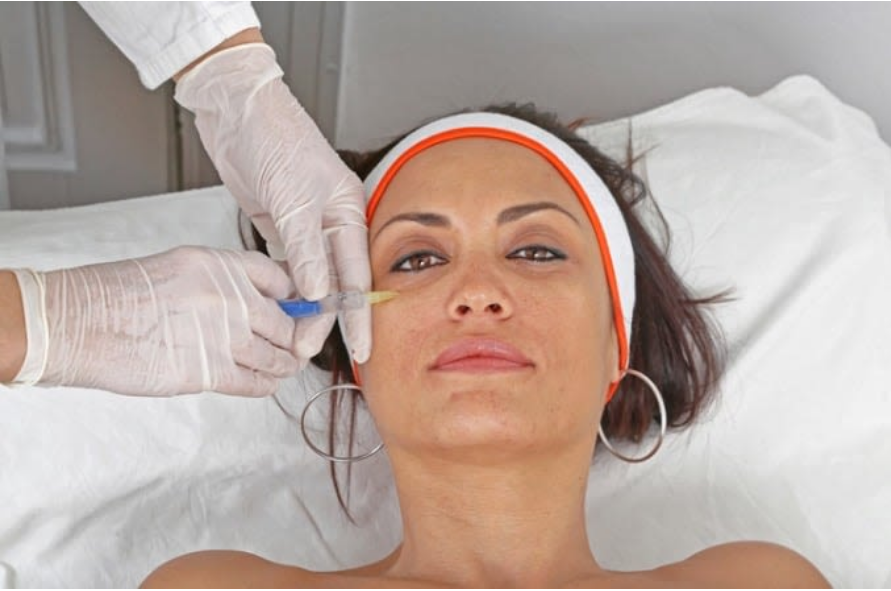
UNDERSTANDS WHEN UNDER EYE FILLER WORKS — AND WHEN IT WHEN DOESN'T
Common concerns include eye bags and dark circles that can make you look older and more tired than you feel. Though there are many possible causes, one of the most common is a volume loss in the area. When the fatty tissues that support your eyes start to break down, they can’t hold up the skin as well as they used to, resulting in sunken hollowed-out eyes.
Dermal fillers are one popular solution for this problem. By injecting a filler into the tissue around your eyes, your doctor can add volume and lift the skin, giving you a youthful appearance.
However, this treatment is only suitable for some. Sometimes, the issue isn’t a lack of volume but a problem with the skin itself. If the skin around your eyes is saggy, prematurely wrinkled, and loose lower eyelid skin, more intense treatments may be required.
In those cases, a medical professional may recommend laser resurfacing, chemical peels, or other medicines that involve removing damaged skin and stimulating the growth of new, healthy skin in its place.
Regardless of what type of treatment you choose, it’s essential to always seek advice from a qualified medical professional before deciding on the best course of action. This will ensure you get the proper treatment for your skin type and situation.
YOU'LL SEE A DIFFERENCE IMMEDIATELY, AND THERE'S NO DOWNTIME
Consider dermal fillers if you’re looking for a way to improve your appearance with little to no downtime. Dermal fillers have become a popular cosmetic treatment to smooth away wrinkles and plump lips, and rejuvenate the skin. The type of filler depends on the filler used; results can last anywhere between six months and a year.
Most fillers are made from hyaluronic acid, a naturally present substance in the skin. This means that there is little to no risk of allergic reaction. Different dermal fillers are available; your doctor will help you determine your needs.
If you’re considering dermal fillers, you should know that the results are not permanent. However, they can last for several months to a few years, depending on the type of filler used. Some fillers can also add volume to thinning areas or reduce wrinkles.
THERE ARE BEST PRACTICES WHEN IT COMES TO AFTERCARE
Many people are unaware that there are best practices when it comes to aftercare following the administration of fillers for under-eye bags. This is likely because most people who get this treatment are over 60 and need to be more active on social media or aware of the latest trends.
Fillers for under eye bags are a quick and easy way to achieve a younger, and the results are usually very long-lasting. However, as with any cosmetic procedure, knowing the potential risks and side effects is vital before treatment.
We will discuss the best practices for aftercare following treatment with fillers for under-eye bags. We will also list things to avoid following your treatment in the days and weeks to ensure the best possible results.
1. Avoid Sun Exposure: Sun exposure and tanning can cause discoloration around the treated area, which could result in an unnatural appearance. Therefore, keeping the treated area protected with a broad-spectrum sunscreen of at least SPF 50 and wearing protective clothing and hats when outdoors is crucial.
2. Avoid Rubbing the Area: Rubbing the area around the eyes, or the injection sites can cause the filler to move or not settle as intended, which could result in a less-than-desirable outcome.
3. Avoid Contaminants: Avoid putting substances such as creams or cosmetics right after filler treatment, as this can contaminate the area and cause infection or inflammation.
4. Exercise Caution When Making Facial Expressions: After a few days, the filler should have settled; it is still vital to ensure that you do not make extreme facial expressions, such as frowning or wide eyes, as this can cause the filler to move.
5. Follow-Up Visits: It is vital to go for regular follow-up visits after your treatment to ensure that the area is healing correctly and that any necessary corrections or touchups can be made.
By following these simple things, you can help ensure that your aftercare goes smoothly and that you experience the best results from your filler injections.
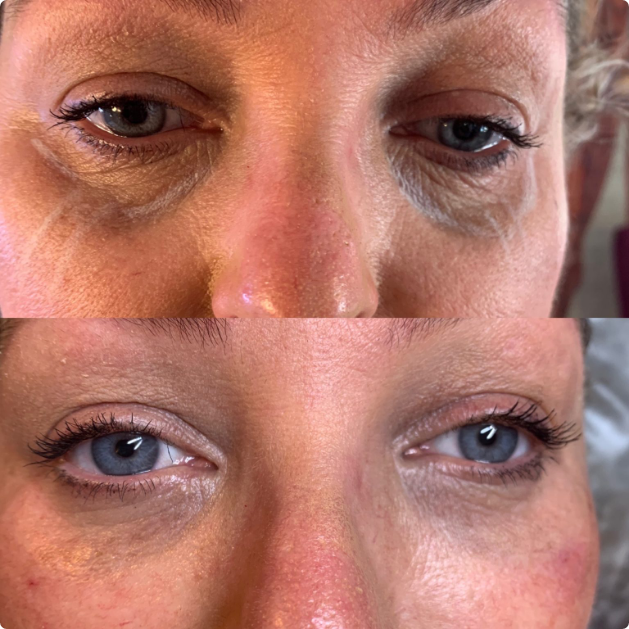
THERE ARE POTENTIAL RISKS AND SIDE EFFECTS
Common side effects include redness, swelling, bruising at the injection site, itching, or tenderness in the area where the filler was applied. These symptoms typically last a few days after treatment but may persist for up to two weeks. Additionally, needles have a risk of infection as well as allergic reactions to specific kinds of fillers.
The most severe risk of under eye fillers is vision loss due to incorrect injection technique or unintentional injection into a blood vessel near the eye. In rare cases, this can cause blockage of blood flow and permanent damage to vision.
Other possible complications include skin discoloration or lumpiness due to uneven application of product or too much development being injected into one spot. These complications usually require additional treatments, such as steroid injections or laser therapy, to correct them.
Fillers are not permanent; the results typically last six to twelve months. After that, the filler is slowly absorbed by the body, and the results gradually diminish. To maintain the results, you must get repeat injections.
While fillers have many benefits, you should be aware of also potential risks and side effects. If you are considering getting fillers, talk to your doctor about the possible risks and side effects. Your doctor may also recommend waiting 12 to 24 months before getting a second treatment.
MAKE SURE YOU GET HYALURONIC ACID FILLERS
Many people suffer from under-eye bags, dark circles, and puffiness. Several factors, such as aging, dehydration, allergies, and genetics, can cause these. If you want to quick, easy way to get rid of under-eye bags, consider getting hyaluronic acid fillers.
In the body, hyaluronic acid is a substance that naturally occurs. It’s responsible for keeping the skin hydrated and plump. Although as we become older, our bodies produce less hyaluronic acid. This can lead to the formation of fine lines, wrinkles, and under-eye bags.
Fortunately, there are several ways to replenish the hyaluronic acid in our bodies. One of the most typical methods is to get hyaluronic acid fillers. These are injected into the skin and help plump the area around the eyes, making under eye bags less visible.
Besides getting fillers, you can also replenish the hyaluronic acid in your body by eating certain foods. Certain fruits, vegetables, and supplements are rich in hyaluronic acid, so include these in your diet.
Try using topical hyaluronic acid serums or creams, which can be applied directly on the skin and aid in hydrating and smoothing wrinkles and fine lines.
Finally, it’s important to remember that hyaluronic acid supplements are also available, and these may provide additional benefits such as joint health, skin and hair health, and improved overall vitality. Always choose a high-quality supplement and take the recommended dosage for the most effective results.
HAVING NEEDLES AROUND YOUR EYES IS JUST AS UNSETTLING AS YOU WOULD EXPECT
As someone who feared needles, the thought of having one near my eye was pretty unsettling. I decided to push through my fear and try anyway, and I’m glad I did. The experience was not nearly as bad as I thought it would be.
Needles are fragile and sharp, so it’s no surprise they can cause some anxiety. But the truth is, they’re not nearly as bad as you might think. The needle used for acupuncture is so thin that you can barely feel it.
If you’re considering acupuncture but are worried about needles, go for it. The experience is better than you think, and the benefits are worth it. Most people who try it once are hooked and continue to reap the rewards of acupuncture for the rest of their lives.
UNDER EYE FILLER CAN LAST ANYWHERE FROM ANYWHERE FROM 6 TO 18 MONTHS
Patients undergoing filler for under eye bag treatment may wonder how long the results will last. The short answer is that under eye filler can last anywhere from 6 to 18 months, although the actual time will depend on some factors.
Some factors that can affect the longevity of an under eye filler include the type of filler used, the injector’s skill, the amount of filler injected, and the individual’s natural metabolism. In general, however, you can expect under eye filler to last at least six months before needing touchups.
It is also crucial to note that the filler’s longevity may be affected by how healthy an individual’s skin is, as this can determine how well filler three is absorbed. Additionally, lifestyle factors such as smoking, drinking, and UV exposure can also influence the longevity of the under-eye filler.
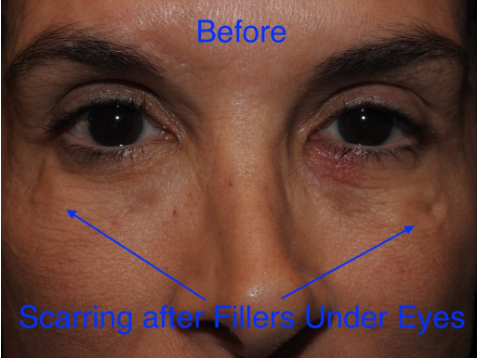
The benefits of under-eye filler include:
– Enhancing the eye’s appearance by reducing the dark circles, wrinkles appearance, and hollowness around the eyes.
– Improving the contours and symmetry of the eyes.
– Creating a more youthful and rested appearance.
Some potential risks associated with under-eye filler include:
– Infection
– Allergic reactions
– Granulomas or lumpy areas
– Skin hyperpigmentation or discoloration
– Impaired vision
– Blood clots
– Damage to nearby skin or nerves
– Skin pH imbalance
– Blindness
– Cardiac arrest
– Nausea
– Skin damage due to improper injection techniques.
Eye fillers are made from hyaluronic acid (HA) or calcium hydroxyl apatite (CaHA). Hyaluronic acid is the most commonly used filler, as it is well-tolerated and produces natural-looking results. Calcium hydroxyl apatite is a synthetic filler with a longer-lasting effect.
IT'S NORMAL TO NEED A FOLLOW-UP APPOINTMENT FOR SOME MINOR TWEAKING
If the results of your Botox treatment do not meet your expectations, it is normal to feel disappointed. However, it is essential to remember that Botox is a temporary treatment, and the results will not last forever. If you are unhappy with your results, you can always book a follow-up appointment with your doctor for a touchup.
It is also customary to experience minor side effects after getting Botox, such as bruising or swelling. However, these side effects usually go away after a few days and should not impact your results too much.
If you are still unhappy with your results after a follow-up appointment, consider trying a different treatment option, such as fillers or surgery.
IS GENERAL ANESTHESIA REQUIRED FOR LOWER EYELID SURGERY?
Lower eyelid surgery, also called blepharoplasty, is a surgical procedure that improves the lower eyelids. The surgery can be performed on both the upper and lower eyelids but is most commonly performed on the lower eyelids.
No, you do not have to be put to sleep for lower eyelid surgery. Lower eyelid surgery can be done under local anesthesia, which numbs the area around your eyes. This type of surgery is usually outpatient, and one can return home the same day. The results of lower eyelid surgery can last for years, and it can help improve the eye area appearance.
Some people have lower eyelid surgery under general anesthesia, which puts patients to sleep during the procedure. This is usually only necessary if you have other types of surgery done simultaneously, such as a brow lift or upper eyelid surgery.
UNDEREYE FILLER IS REVERSIBLE, BUT IT CAN BE A LONG AND PAINFUL PROCESS
If you’re considering getting under eye filler, it’s essential to know that the effects are not permanent, and removing the filler can be long and painful.
While removing the filler is not fun, knowing it is reversible is essential, and you can return to your natural look. So, if you’re considering getting undereye filler, carefully weigh the pros and cons before deciding.
While the process is generally safe, some risks include bruising, swelling, and infection. The good news is that if you’re unhappy with the results, the filler can be dissolved with an injection of hyaluronidase. However, this process can be painful and may take several weeks or even months to reverse the filler’s effects fully.
Additionally, seek out a board-certified professional with injectable expertise before getting treatment. They can provide the best advice for achieving your desired results in the safest way possible.
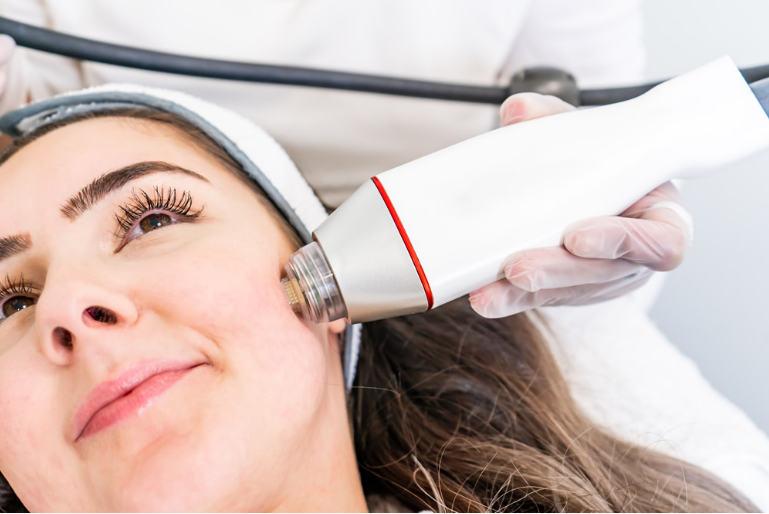
HOLLOWING OF THE UNDER EYES CAUSES INSUFFICIENT CHEEK VOLUME
Fat transfer is a cosmetic procedure involving injecting fat from one part of the body and injecting it into another. This is often done to add volume to the face.
While fat transfer can be a successful procedure, it is not recommended for thin eyelid skin. This is because there is a risk of the fat being absorbed by the body or causing lumps and bumps under the skin. If you are considering fat transfer for your eyelids, speak with a board-certified plastic surgeon to discuss your options.
For several reasons, the fat transfer should not be performed in thin eyelid skin:
The fat cells are much more likely to be reabsorbed by the body in delicate skin.
Fat cells are more likely to migrate to other areas in thin skin.
Soft skin is much more likely to be wrinkled and sag over time.
While fat transfer can be a successful procedure, it is not recommended for thin eyelid skin. This is because there is a risk of the fat being absorbed by the body or causing lumps and bumps under the skin.
CAN FILLERS BE USED UNDER EYE BAGS?
Fillers can reduce the under eye bags, but there are risks and side effects to consider before treatment. These fillers can sometimes cause bruising, swelling, and numbness. The filler is also likely migrating to other parts of the face.
Many people experience under eye bags at some point in their lives. Several factors, including genetics, aging, and fatigue, can cause these. While some treatments are available to help reduce the under eye bag’s appearance, fillers are one of the most popular and effective options.
Fillers can plump up the skin and reduce the under eye bag looks. The results are typically temporary, but they can last for several months before needing to be touched up. Some different types of fillers can be used under the eyes, so it’s always essential to get advice from a professional to find the best option.
PLATELET - RICH PLASMA (PRP) FOR SKIN PIGMENTATION AND THICKNESS
PRP is a concentration of platelets and growth factors that can be injected into the skin to help improve skin pigmentation and consistency. PRP therapy has been used for years to help improve wound healing and enhance tissue regeneration.
PRP therapy can be done as an in-office procedure, and the results are usually visible within a few weeks. PRP therapy is a secure and effective way to improve appearance, and how is used on all skin types.
PRP treatments are relatively new but have already shown promising results in early studies. If you want PRP for skin pigmentation or thickness, consult a board-certified dermatologist to see if you are a good candidate.
WHAT IS THE BEST FILLER FOR UNDER-EYE HOLLOWS?
Many injectable fillers can be used to reduce the under eye hollows’ appearance. Some of the most popular fillers for under eye hollows include Restylane, Juvéderm, and Belotero. The best filler for this purpose depends on your needs and goals.
Hyaluronic acid filler called Restylane adds volume to the under eye area. Juvéderm is another type of hyaluronic acid filler for under eye hollows. Belotero is a dermal filler that is made from a kind of collagen. It can add volume to the area around the eyes and reduce lines and wrinkles.
However, there are a few different fillers, so selecting the right one for your needs is crucial. Here, we’ll give you a brief overview of the most popular fillers for under-eye hollows and how they work to smooth the area and restore youthful volume.
1. Hyaluronic Acid Fillers – Hyaluronic acid fillers, like Restylane, Juvéderm, and Volbella, help create a younger appearance by adding volume to hollows under the eyes. The results typically last six to twelve months and are ideal for treating wrinkles and fine lines.
2. Collagen Fillers – Collagen fillers, such as Sculptra and Evolence, comprise natural proteins in your skin. They create scaffolding and a more substantial base, providing more hold for younger-looking skin. Collagen fillers take longer to take effect, as the results will only be visible for a few months. The results are shorter than hyaluronic acid fillers, lasting up to one year.
3. Fat Transfer – Fat transfer is a more permanent option for treating under-eye hollows. During this treatment, a doctor removes fat from a donor area, such as the buttocks or thighs, and then injects it into the hollows under the eyes. The results from this procedure typically last five to seven years.
4. Chemical Peels – Chemical peels can help smooth out wrinkles but may not be the best choice for deep under-eye hollows. Chemical peels can temporarily lighten the looks of under-eye circles, but like fat transfer, this is not a permanent solution.
5. Microneedling – Microneedling uses fine needles that puncture the skin as a treatment, which can help stimulate collagen production, collagen remodeling, and cell regeneration. This method can help with wrinkles and other age-related symptoms, such as dark circles or discoloration under the eyes.
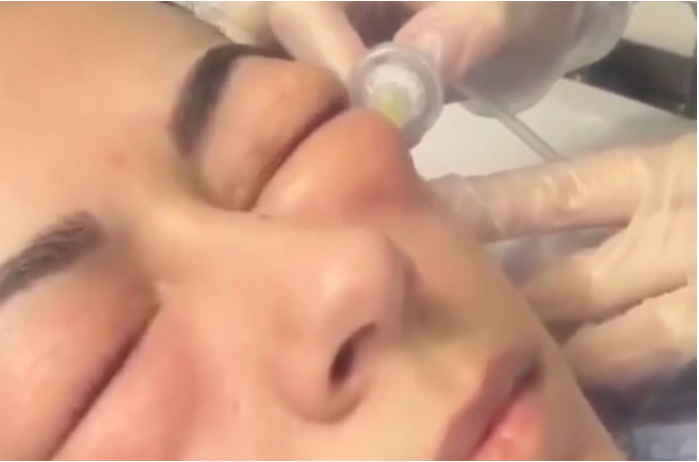
BEST EYE FILLER FOR HOLLOW EYES/TEAR TROUGHS
There is yet to be a widely accepted answer to the best eye filler for hollow eyes or tear troughs. The best filler for you will depend on your specific requirements and goals. Often, hyaluronic acid is the best filler for hollow eyes or tear troughs. This is because it is a very effective way to plump the skin and minimize wrinkles and fine lines.
Fillers are injected into the skin using an excellent needle. However, a few other fillers can also be used to achieve a similar result. For example, you could also use collagen or fat grafting. Depending on your needs, the filler used on individual needs and the advice of your cosmetic surgeon.
The most common fillers used for under-eye bags are hyaluronic acid-based fillers such as Juvederm. Cosmetic eyelid surgery is typically performed under local anesthesia or twilight sedation. The surgery usually takes about one to two hours to complete.
If you have mild to moderate hollowing under your eyes, you may get away with using a hyaluronic acid filler like Juvéderm or Restylane. These fillers can assist in plumping skin as well and reduce dark circles.
You may need a thicker filler like Radiesse or Sculptra if you have more severe hollowing or tear troughs. These fillers add volume to the area and give you a youthful appearance. Other treatments, such as microneedling or laser resurfacing, may also be beneficial for treating this area.
Does tear trough filler change your face?
Dermal fillers include tear troughs used to correct the appearance of the tear trough or the hollows under the eyes. Injecting the filler into the tear trough area will add volume and minimize the dark circles and hollow appearance.
So, does tear trough filler change your face? The answer is yes and no. The filler can help to improve the appearance of the tear trough area, but it will not change your look entirely.
Tear trough filler is injected into the tear trough, the area under the eye where the eyelid meets the cheek. This can help plump the skin, reduce wrinkles and fine lines, and create a youthful appearance. However, the tear trough filler will not change your face. It will not alter your features or make you look like someone else.
Fat grafting is the longest-lasting option, with results typically lasting 2 to 5 years. Tear trough fillers can last anywhere from 6 to 18 months, depending on the type of filler used and the individual’s skin. Hyaluronic acid-based fillers generally last 6 to 12 months, while collagen-based fillers last up to 18 months.
PLATELET – RICH PLASMA (PRP) FOR DARK CIRCLES
Platelet-rich plasma (PRP) is a promising option for dark circles, but more research is needed to confirm its efficacy. It is a concentrated solution of platelets and other blood cells that can promote healing and regeneration. When injected into the skin, PRP can help improve dark circles’ appearance by increasing collagen production and blood circulation.
Platelet-rich plasma and growth factors that can promote healing. PRP is often used to treat injuries but is also being studied for various conditions, including dark circles.
Dark circles are a common cosmetic concern. While various factors can cause them, including genetics, lifestyle, and medical conditions, the most common cause is dehydration. PRP is a promising treatment for dark circles because it can help stimulate collagen production and improve blood circulation.
A small study published in 2018 found that PRP effectively treated dark circles. The study included 20 participants who were divided into two groups. One group received PRP injections, while the other received a placebo. The findings showed that the participants who received PRP had significantly improved dark circles compared to those in the placebo group.
INJECTABLE FILLERS COST
The market for injectable fillers is expected to increase in the coming years as more and more people seek treatment for under-eye bags. Fillers are famous for this condition because they offer a non-surgical alternative to more invasive procedures, such as blepharoplasty.
These fillers can assist and improve under-eye bag looks, but they don’t cure. The results of under-eye fillers are not permanent, and the effects will typically last for around 6 to 12 months. After this, the under-eye fillers must be repeated to maintain the results.
The cost of under eye fillers varies depending on the size of the treatment area, the type of filler used, and the geographical location. However, as a general guide, these fillers can cost anywhere from $600 to $1,200 per syringe.
The price of fillers varies depending on the filler type used and the number of syringes required. However, the average cost of treatment is between $600 and $900. Fillers are typically not covered by health insurance, so patients must pay for the procedure out of pocket.
How Much Does Asian Eyelid Surgery Cost?
Asian eyelid surgery is a standard treatment among Asians who want to change the shape of their eyes. Double eyelid surgery, often known as Asian eyelid surgery, is a type of cosmetic surgery performed to create a crease in the eyelid. This crease can make the eye appear larger and more open. The surgery can be performed on both the upper and lower eyelids.
The cost of Asian eyelid surgery will vary depending on the surgeon, the location, and the type of surgery being performed. Generally, the surgery will cost between $2,000 and $4,000.
However, prices can be higher or lower depending on the procedure’s complexity and the patient’s needs. Some clinics may offer financing or payment plans to help make the process more affordable.
CAN UNDER-EYE FILLERS GO WRONG?
There are a variety of cosmetic procedures that people can undergo to improve their appearance, including fillers for under the eyes. However, as with any surgery, there is always the potential for something to go wrong.
What are the risks of under eye fillers? The most common complication is bruising, usually resolved with ice and time. However, there is also the potential for more severe complications, such as vision problems, infection, and blindness.
Of course, the chances of something going wrong are relatively small, but it’s essential to understand the risks before undergoing any cosmetic procedure. There is always the potential for complications. Under eye fillers’ most common side effects include bruising, swelling, and redness. However, more severe complications can occur, such as infection or blindness.
Additionally, if the filler is not administered correctly or the type used is incorrect, it can cause permanent damage. It is essential to consult with a trusted professional before undergoing a cosmetic procedure to ensure it will be performed safely and effectively.
Understanding the Recovery Timeline for Ptosis Eyelid Surgery
Eyelid ptosis surgery is a procedure to improve the drooping of the upper eyelid. The surgery can correct drooping caused by aging, injury, or a condition present at birth (congenital ptosis). It is also called eyelid lift surgery or upper blepharoplasty.
The surgery is usually brief, taking only 30 minutes to an hour. And most people report very little pain after the surgery. In most cases, people can return to normal activities the next day.
The majority of people will have a significant improvement in their ptosis after surgery. However, a small percentage of people may still have some eyelid drooping. However, it may take a few weeks before you see the full results of the surgery.
The surgery is usually safe and effective, but it is crucial to understand the potential risks and complications before undergoing the procedure. Recovery from eyelid ptosis surgery usually takes 1-2 weeks. During this time, it is essential to rest and avoid strenuous activity. Bruising and swelling are normal and typically resolve within 2-3 weeks.
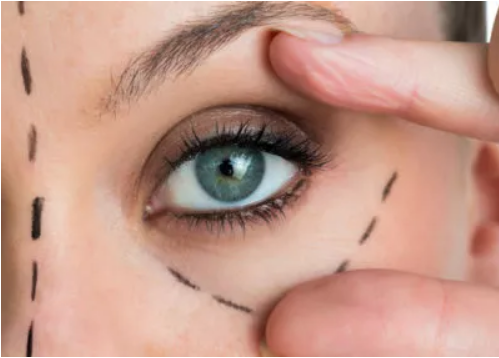
FILLERS CAN TREAT SOME INSTANCES OF EYE BAGS
Several factors can cause eye bags, including genetics, aging, and fluid retention. In some cases, fillers can be used to treat eye bags. Although surgery is the only way to remove excess fatty tissue below the eyelids, filler injections can sometimes minimize eye bags’ appearance.
Eye filler treatment involves injecting a dermal filler into the skin under your eyes. Injectable fillers add volume to the skin, softening wrinkles and fine lines looks. They can also plump up facial parts that have lost volume due to aging.
Regarding eye bags, filler injections can help camouflage the bulging of the fat pads. This can make the eye bags less noticeable and give a smoother, more youthful skin surface.
Fillers are injectable substances that can add volume to the skin. They can be made from various materials, including hyaluronic acid, collagen, and fat. However, the results of eye filler treatment are temporary solutions and must be re-injected every few months to maintain the results.
Is eye bag removal painful?
There is no easy answer when it comes to pain and procedures. Everyone experiences pain differently, and what one person deems unbearable might be manageable for another. That said, most people report feeling discomfort during and after eye bag removal surgery.
Of course, everyone’s pain tolerance is different, so that you may experience some discomfort during the numbing process. But once the area is numb, you shouldn’t feel any pain. Additionally, your doctor can provide pain medication to ensure comfort during and after the procedure.
Bag removal surgery can be performed on an outpatient basis, meaning return home the same day as your surgery. The surgery usually takes about two hours, and local anesthesia will be administered to numb the area.
And while you may experience some swelling and bruising after the procedure, this is usually minor and resolves within a week or two. If you want to get rid of anything, those dark circles, eye bag removal is the way to go.
HOW LONG DOES UNDER-EYE FILLER LAST?
When considering this procedure, it’s crucial to understand how long under-eye filler results last. Generally speaking, results will typically last anywhere from six months to one year after being injected into the skin.
However, lifestyle habits (like smoking or excessive sun exposure) may cause them to fade sooner than expected. Therefore, if you want long-lasting results with minimal touchups over time, taking good care of your skin before and after treatment is best.
Another essential aspect of under-eye filler is safety considerations. As with any medical procedure, there are some risks associated with dermal fillers; however, these risks can be minimized by working with an experienced professional who has expertise in facial anatomy and injection techniques.
Results vary depending on the filler used; It can last several months to a year. Results, however, may vary from person to person. In general, it is recommended that patients get touchups every 6 to 12 months to maintain results.
What age should you get eye fillers?
Regarding eye fillers, age is an essential factor to consider. Generally speaking, people over 25 are most likely candidates for this type of procedure. There is no set age for when someone should get eye fillers, and the decision should be made on a case-by-case basis.
The goal of eye fillers is typical to reduce wrinkles, dark circles, and hollows around the eyes. Our skin loses elasticity and volume as we age due to sun exposure and decrease collagen production. These are visible signs of aging symptoms, such as sagging skin, wrinkles, and dark circles around the eyes. Eye fillers help restore volume in these areas, reducing the appearance of wrinkles or hollows.
Your doctor will evaluate your individual needs and make recommendations about whether or not it’s appropriate for you; consider getting eye fillers at any age based on your medical history and goals for treatment. Also, remember that there may be risks associated with this type of procedure, so discuss these with your doctor before deciding to get an eye filler treatment done.
CORRECTING VOLUME USING FILLERS AFTER EYE BAG SURGERY
There is no substitute for corrective surgery when looking and feeling our best. Eye bag removal has become increasingly popular to reduce under-eye bags and signs of aging. Still, the results can sometimes be unsatisfactory due to volume loss in the area. Fortunately, there are ways to correct this loss by using fillers.
We’ll discuss how filler treatments can help reverse volume loss after eye bag surgery, restoring a youthful look to the eyes.
Filler treatments can be an effective way to restore volume loss after eye bag surgery. Eye bags, or lower eyelid fat pads, are often surgically removed to improve the eyes’ looks and reduce puffiness.
However, when this fat is removed, it can leave behind a hollowed-out look in the area underneath the eyes. Filler injections replace lost volume and create a smoother contour in the mid-face region near the eyes.
Fillers come in many forms, including hyaluronic acid (HA) fillers such as Juvederm ultra plus and Restylane, collagen stimulators like Sculptra, autologous fat transfer (AFT), polymethylmethacrylate microspheres (PMMA) like Bellafill, and calcium hydroxylapatite (CaHA) like Radiesse.
Each filler has different properties that allow them to provide various aesthetic improvements for patients with volume loss after eye bag surgery or other causes of facial aging. Hyaluronic acid fillers are ideal for addressing mild to moderate volume loss because they naturally attract water molecules and help hydrate tissue while adding fullness where needed.
Collagen stimulators stimulate collagen production to gradually increase skin elasticity while helping smooth out facial wrinkles and creases. Autologous fat transfer involves taking small amounts of body fat from one area of your body, such as your tummy or thighs, before transferring them into areas where you need more fullness, such as your cheeks.
WHAT CAUSES UNDER-EYE HOLLOWS?
Eye hollows, or tear troughs, are among the most common issues people face regarding appearance. These dark circles or hollow areas beneath the eyes can cause a person to look older and more tired than they are.
Understanding what causes under-eye hollows is crucial to determine how best to treat them.
Causes of under-eye hollows can be due to various reasons, ranging from genetics to lifestyle choices.
1. Genetics: Some people are born with thinner or weaker skin around the eyes, which can lead to hollows forming more easily. You cannot control this and therefore have little choice in preventing it.
2. Aging: As we age, our skin becomes thinner and less elastic, resulting in a sunken look around the eyes as our facial muscles relax and fat stores around the eyes decrease. This inevitable process often leads to deeper eye hollows with advancing years.
3. Stress & Lack of Sleep: Stress levels can cause us to lose sleep, leading to dark circles and puffiness under the eyes that may make us appear older than we are; this could also contribute to making eye hollows appear more prominent over time if not appropriately addressed by getting adequate rest each night.
4. Diet & Nutrition: Eating an unhealthy diet low in essential vitamins and minerals can cause your body to become malnourished, leading to dry skin that results in sagging or wrinkling of our facial features, including under-eye areas – this will then make eye hollows appear more pronounced even when they’re not present naturally due lack of necessary nutrition needed for healthy skin maintenance.
Tips for reducing the appearance of Under Eye Hollows:
1. Get Enough Sleep: Lack of sleep or poor sleep quality can cause dark circles and hollows to appear more prominent. Make sure to get at least eight hours of restful sleep each night.
2. Use Hydrating Eye Creams: Daily hydrating eye cream helps minimize under-eye hollows by providing moisture and nourishment for the skin around the eyes. Find products that contain ingredients like hyaluronic acid, vitamin E, and ceramides to provide extra hydration.
3. Avoid Alcohol And Caffeine: Excessive consumption of alcohol and caffeine can make your skin look dry and dull, contributing to under-eye hollows appearing more prominent. Try to limit your intake or cut them out entirely if possible!
4. Use A Highlighter: To brighten up the area underneath your eyes instantly, use a highlighter along with concealer to reflect light away from any shadows in that area—this will help make your under eye area look brighter and less worn-looking!
5. Eat A Healthy Diet: Eating a balanced diet rich in fruits, vegetables, proteins, healthy fats, vitamins, and minerals can help improve skin health overall—including reducing those pesky under-eye hollows!
DOES UNDER-EYE FILLERS HELP WITH WRINKLES?
Age-related symptoms such as wrinkles and fine lines become more prominent around our eyes. For those who are trying for a way to reduce their appearance, under-eye fillers may be an option worth exploring.
These fillers are a type of injectable dermal filler that helps reduce wrinkles and bags under the eyes. The fillers are usually made up of hyaluronic acid, a naturally-occurring substance found in the body that can help to restore volume and hydration to areas where it has been lost as a result of aging or other factors.
They reduce wrinkles, including crow’s feet and marionette lines (the lines at the corners of your mouth), Nasolabial folds, also known as laugh lines or smile lines, are the two facial creases that extend from either side of the nose to the corners of the mouth.
They can also be used to add volume and lift sagging skin around the eyes for a more youthful look. When injected into targeted areas, these fillers plump up skin tissue that has become thinned out due to age, resulting in smoother-looking skin.
In addition, they may help to brighten dark circles under the eyes by improving circulation and lightening discoloration caused by pigmentation issues or genetics.